| |
A Virtual Walk Through Jacksonville History
Stop 26: Peter Britt House & Gardens
After a brief climb up First Street to Pine, we find ourselves at the entrance to Britt Gardens, near the former site of the home of Peter Britt, famous Oregon photographer, painter, horticulturist, vintner, orchardist, beekeeper, overall renaissance man, and his family. While no photographs of Britt’s original 1852 dugout cabin (described by Rev. T.J. Royal as a “split lumber hut surrounded by pack saddles”) exist, there is one illustration which depicts the original cabin behind a later structure:
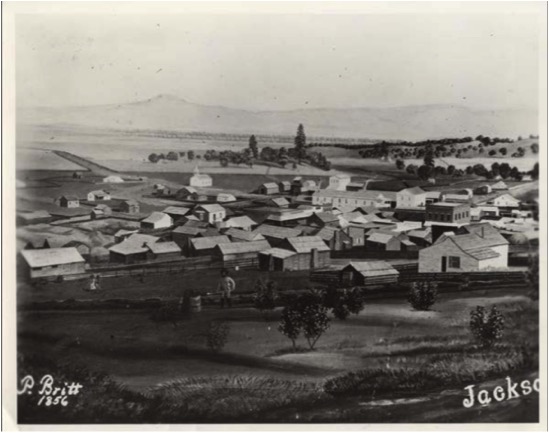 Illustration by Peter Britt, 1856, looking Northeast, overlooking his homestead and Jacksonville. Illustration by Peter Britt, 1856, looking Northeast, overlooking his homestead and Jacksonville.
The wood frame house is center right, with the original cabin behind it.
In contrast, we are fortunate to have many photographs and sketches of the home he built in 1856, where he and his family lived over the years.
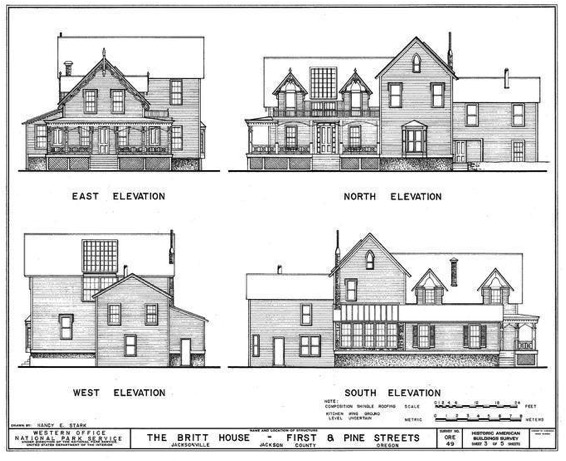 Historic American Buildings Survey, HABS 00003a Historic American Buildings Survey, HABS 00003a
Britt constructed his wood frame house approximately twenty-five feet back from First Street, at Pine, facing east. Originally a modest, one story dwelling, it had a Classical Revival cornice with a north slope skylight to accommodate Britt’s photography studio. The building was remodeled and expanded over time as the Britt family grew, and a second floor was added with dormer windows to help light the studio. The house eventually incorporated decorative “gingerbread” trim, in the “cottage gothic” style.
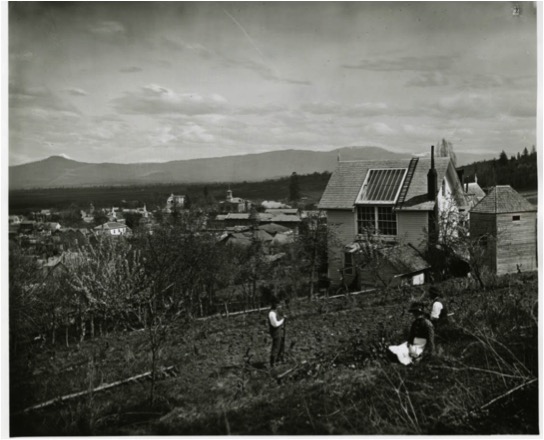 Southern Oregon Digital Archives, BRIT01i_20-39.tif Southern Oregon Digital Archives, BRIT01i_20-39.tif
By 1882, the house was three-storied with fourteen rooms, a large wine cellar, and attached solarium.
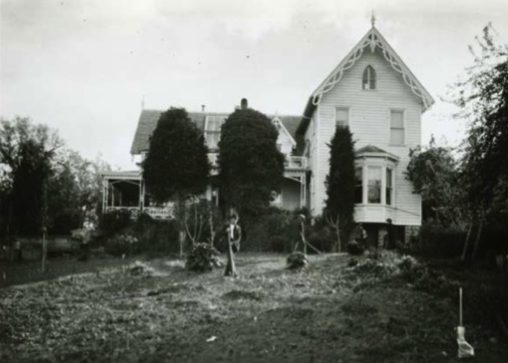 Southern Oregon Digital Archives, BRIT01i_4-40.tif Southern Oregon Digital Archives, BRIT01i_4-40.tif
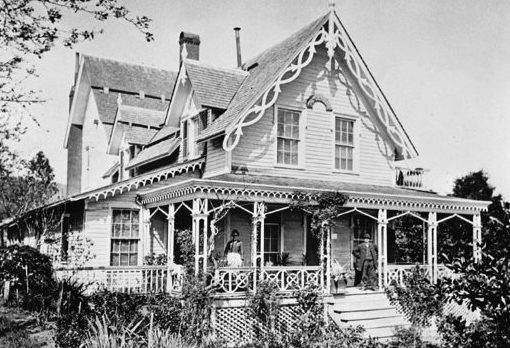 East Elevation, HABS No. ORE-49 East Elevation, HABS No. ORE-49
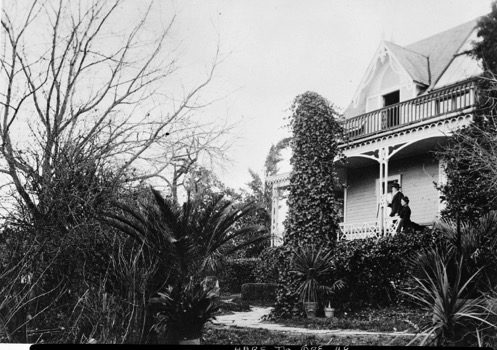 West Elevation, HABS ORE-49 West Elevation, HABS ORE-49
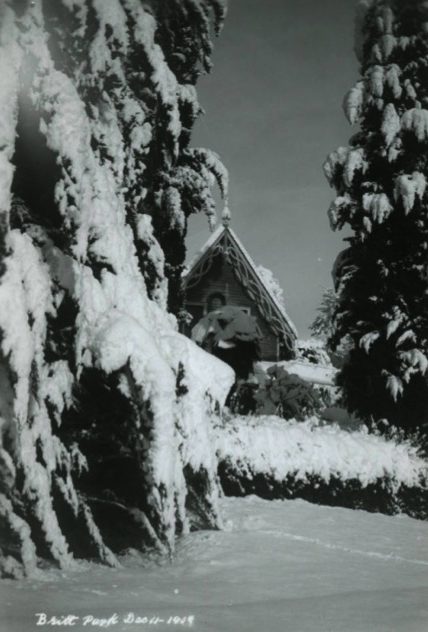 “Britt Park in Winter” December 11, 1909, Southern Oregon Digital Archives “Britt Park in Winter” December 11, 1909, Southern Oregon Digital Archives
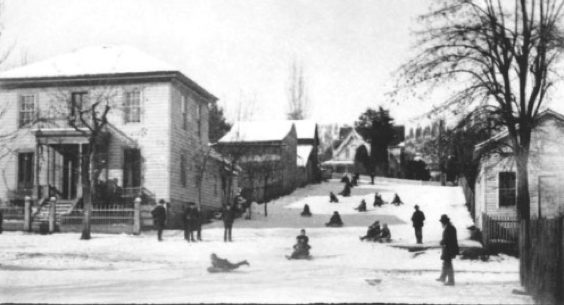 SOHS. In this photograph, taken from Oregon Street and Pine, SOHS. In this photograph, taken from Oregon Street and Pine,
the Herman von Helms house is on the left corner, and the Britt house is visible at the top of the hill, on First Street.
Britt’s homestead historically occupied over eighty acres, and the northern portion of the property where the house and gardens were located is what we now know as Britt Gardens. Heirloom fruit trees and other plantings survive from the time the family lived there, as well as the giant sequoia tree Peter Britt planted in 1862 on the occasion of his son Emil’s birth.
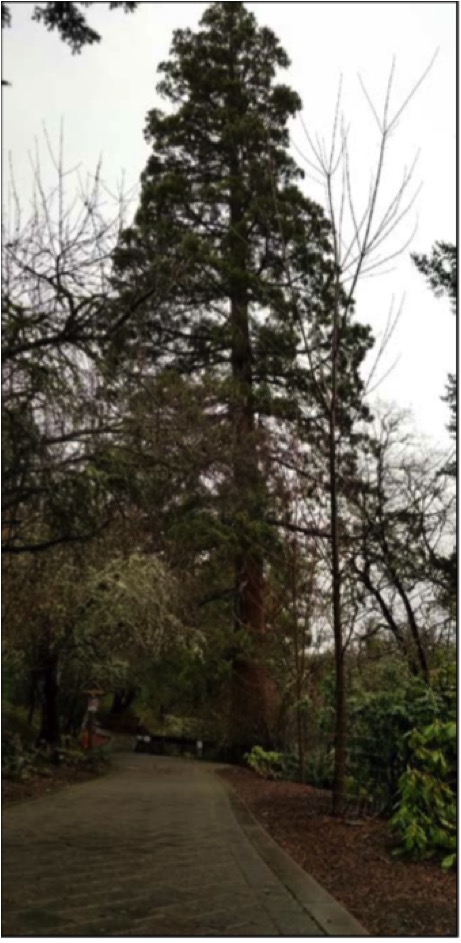 Chelsea Rose, 2019 Chelsea Rose, 2019
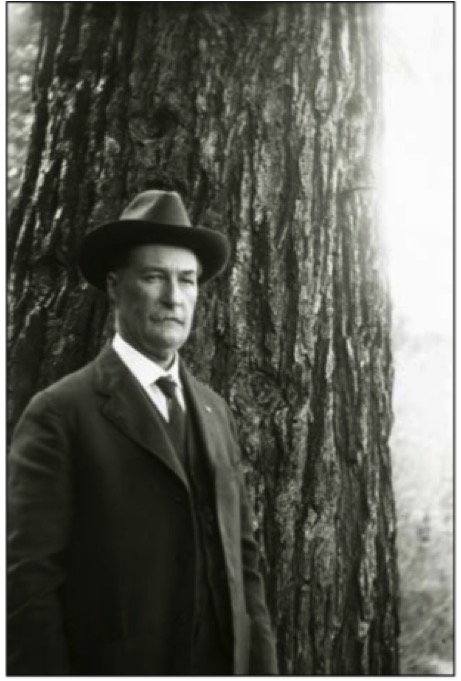 Emil Britt standing next to the giant sequoia, Southern Oregon Digital Archives, BRIT01i_10-75.tif Emil Britt standing next to the giant sequoia, Southern Oregon Digital Archives, BRIT01i_10-75.tif
The Southern Oregon University Laboratory of Anthropology has been conducting archeological excavations at this site since at least 2010, and items such as table wear, photography equipment and personal possessions have been excavated and catalogued. Although the house was destroyed by fire in 1960, a masonry “foundation” outlining the original 1882 footprint of the house was constructed in 1976 and remains there today, as well as the octagon-shaped fountain we can see in earlier photographs.
The importance of this site, both historically and archeologically, truly can’t be overstated.
| While homestead sites are commonly found across the state, there are many aspects of the historical context, circumstance and condition of the Britt Gardens … that make it remarkable. This well-preserved site can be clearly linked [to] a single immigrant family over two generations, and the resultant archeological deposits are complimented by a robust documentary record of photographs, diaries, letters, and family heirlooms. Furthermore, the second generation lived in a curated tableau of their father’s achievements, providing us with a rare window into the liminal phases of the early 20th century myth- and placemaking where Oregon’s pioneer past was solidifying into the self-congratulatory narrative of the American West that scholars work to deconstruct today. |
National Register of Historic Places Registration Form, Britt Gardens Site 35JA789.
Our next stop… what’s that? What about Peter Britt himself? We could spend the rest of the day right here, talking about Peter Britt, he was such an accomplished man! Were you to Google “Peter Britt” you could spend hour after hour reading about his impressive talents. But let us mention just a few highlights about his amazing life.
Peter Britt was born in Switzerland and came across the Oregon Trail with hundreds of pounds of photography equipment, arriving in Jacksonville in 1852 and living the rest of his life here. After trying gold mining and mule packing, Britt decided in 1856 to become a full-time photographer. He is best known for his portraits, including those of most of the citizens referenced on our tour, as well as photographs of farmers, miners, Chinese and Native Americans. He is also remembered as the person who took the first successful photograph of Crater Lake, and his photos helped persuade Congress to make Crater Lake a national park.
Britt was also an accomplished painter, which is how he made his living in Switzerland. Later in Oregon, he painted scenes in Switzerland from memory, his family members, as well as landscapes here in Oregon.
Peter Britt also established Oregon’s first winery, and had been growing grapes and selling wine in Jacksonville as early as 1880. He is known as the father of Southern Oregon’s fruit industry, and was an avid horticulturalist. He invested in land, and is said to have held deeds to over 2,000 acres. He served on the Jacksonville City Council twice, and while he was an agnostic, his children were baptized into the Presbyterian faith by Reverend Moses Williams, whom we heard about earlier on this tour (Stop #6).
One particularly sweet story is of how Peter married his wife, Amalia. While still living in Switzerland, Peter and his brother Kaspar courted Amalia and her sister Anna. The girls’ father approved of Kaspar, but not of Peter, whose occupation as a portraitist-for-hire wasn’t good or steady enough in Papa’s opinion. Kaspar and Anna immigrated to the United States, Amalia married a distant cousin (also Kaspar) and in 1854 the couple also immigrated to the United States with their infant son, Jacob.
Fast forward to 1861, when Kaspar Britt writes Peter to inform him that Amalia has become a young widow and with her son Jacob, has been left with no income. Peter wrote to Amalia immediately, and sent her enough money to either return to Switzerland, or to come to Oregon to be his wife. Amalia chose Britt, and after a difficult journey around the Horn, then by steamer to Crescent City, then by stage to the Applegate stop, Peter met Amalia and Jacob there, and brought his new family to Jacksonville. The two were married at the home of Kaspar Kubli, a fellow Swiss immigrant.
One year later, Amalia bore a son, Emil, for whom Peter planted the giant sequoia tree pictured above, which remains to this day. The Britts had another son, Arnold, who lived only three months, and a daughter nicknamed Mollie, who lived here on the property until 1954.
Amalia passed only ten short years after her marriage to Peter. Peter died in 1905, and none of his children married, but for fifty years he recorded the people, places and events of Jacksonville and Southern Oregon.
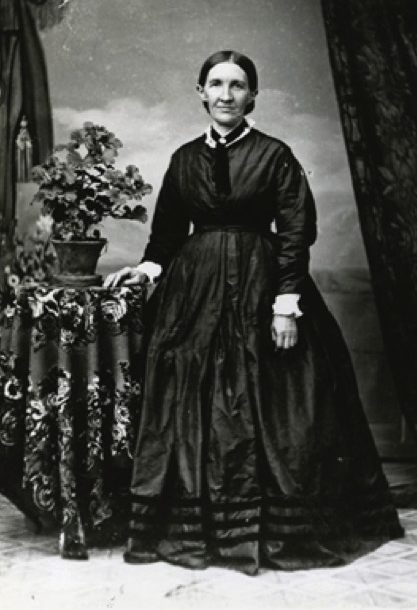 Amalia Britt, SOHS Amalia Britt, SOHS
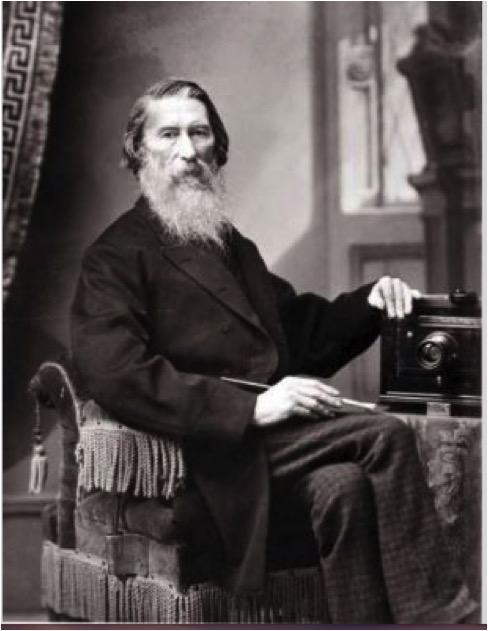 Peter Britt, SOHS Peter Britt, SOHS
Sources Cited
National Register of Historic Places Registration Form, Britt Gardens Site 35JA789.
Kingsnorth, Carolyn. “Pioneer Profiles” Peter Britt, Parts 1, 2, and 3. Jacksonville Review, July, August and September, 2019
|